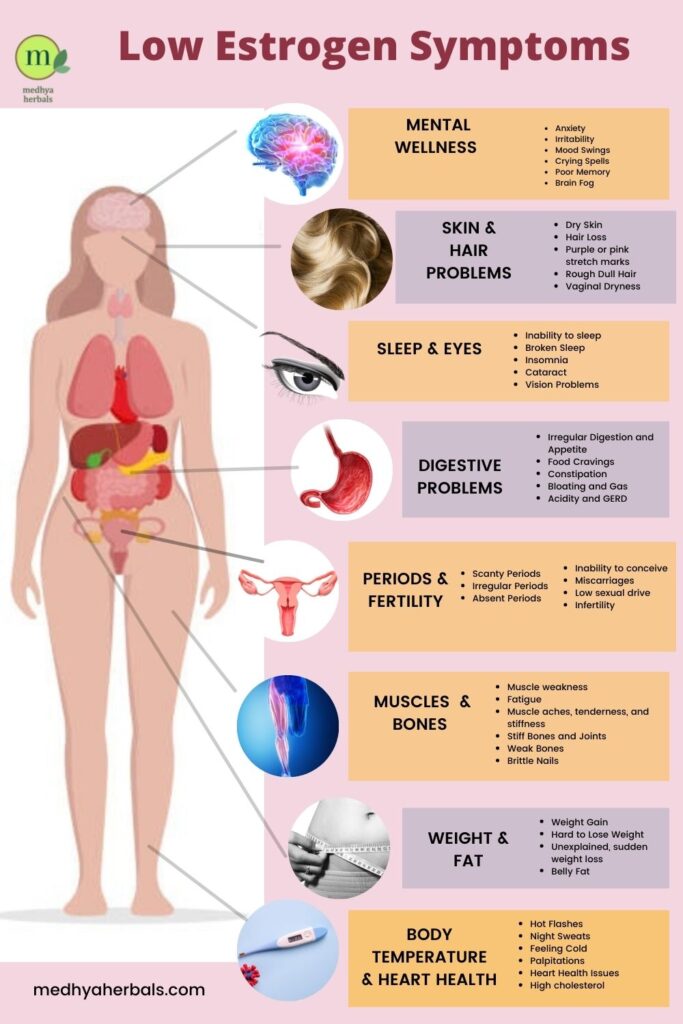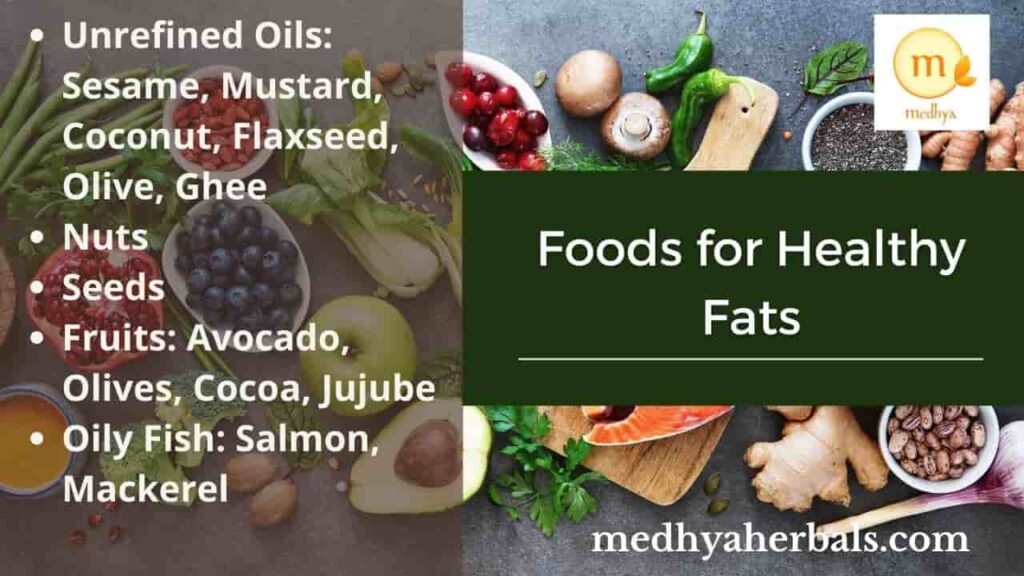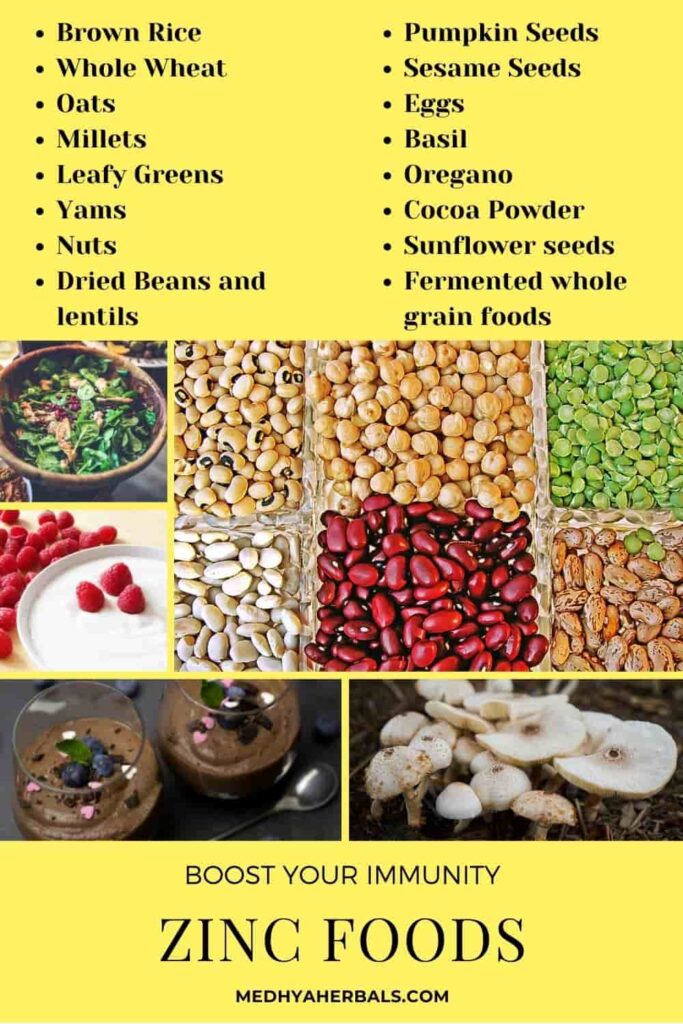Hot flashes have taken a toll on your days. You wake up with night sweats and can’t fall back to sleep. Sometimes you’re anxious, feeling low and unable to put your thoughts and mind together.
Your periods are becoming lighter, irregular and not even showing up at times. As if this wasn’t enough, it seems bloating and acidity have become the norm of how you feel inside your belly.
What’s going on?
Well, all of these are signs of Low Estrogen levels in your body. You shouldn’t ignore them but act on it immediately. This is because, low estrogen symptoms indicate hormonal imbalances that have progressed a little bit too far.
Your body isn’t able to handle this poor state of health anymore. And it is giving you signs to pay attention to your diet, your lifestyle and how you carry yourself around. A little (or perhaps a bit more) self care is needed.
In this post you will learn about low estrogen symptoms, what causes low estrogen levels in the body and how you can naturally boost your estrogen levels. Let’s get started!
The Three types of Estrogen Hormone
Estrogen is present in our body in the form of three chemically similar hormones that includes estrone, estradiol (the most abundant in women of reproductive age) and estriol. These hormones are produced in the ovaries, adrenal glands and fat tissues.
Each of this form is active at a certain stage of life. They differ in the potency level and based on the source of production.
1. Estradiol
Estradiol is the most potent naturally occurring estrogen hormone. It is abundant in younger women as it is regularly produced during each menstrual cycle by the ovaries.
Estradiol levels decline during menopause. However, it is still produced by the ovaries in much smaller amounts after menopause.
2. Estriol
Estriol is the primary estrogen produced by the placenta during pregnancy. It is the weakest of all three forms of Estrogen.
Estriol is present in maximum concentration during pregnancy, thus making it the dominating Estrogen during that time. It is responsible to stimulate the growth of prolactin hormone and hence lactation after the delivery.
3. Estrone
This form of Estrogen is the most abundant in the body after menopause. It is less potent than Estradiol and more potent than Estriol.
Estrone is largely produced by the fatty tissues and the adrenal glands through the conversion of DHEA hormone.
Thus, if you have more fatty tissues; then you may be prone to high Estrogen or Estrogen dominance in menopause.

Estrogen Function for Women Health
Estrogen is a growth hormone responsible for the development and maintenance of the female reproductive system. It is released in high amounts during the follicular phase of the menstrual cycle.
The main functions include building up the uterine wall for the menstrual cycle, stimulating the growth of the egg follicle, developing breast tissue, stabilizing bone density, and controlling the metabolism of glucose and lipids.
1. Estrogen Hormone affects Mental Wellness
- It controls the functions of the nervous system
- It improves the effects of endorphins (feel-good chemicals).
- Low Estrogen causes anxiety issues.
2. Estrogen maintains your body Temperature
- Estrogen acts on the hypothalamus and helps to maintain body temperature, thus keeping the body warmer or colder through peripheral functions as sweating and blood circulation.
- This is the reason for Hot Flashes and Night Sweats experienced during pregnancy, menstrual cycles, and during Menopause.
3. Supports Bone Health
Low or no Physical Activity, low level of Nutrition, and Low Estrogen together hit the bone health very hard in and after Middle Age. More than 50% of women complain of joint pain or back pain.
- Estrogen promotes growth of bone tissues as it supports the osteoblasts, the cells that form new bone, and accelerates their function.
- It regulates bone density and improvises bone strength.
- Estrogen reduces leaching out of Calcium, hence prevents bone loss. Low Estrogen level during and after Menopause is also the reason of poor bone density and bone health issues.
4. Skin and Hair Health
- Estrogen controls quality of hair tissues. It directs growth of hair follicles and prevents hair loss and thinning.
- Estrogen improves skin quality and elasticity.
- It guides protein metabolism and enhances collagen production.
- Low Estrogen levels are often the reason behind dry, inflamed, and wrinkled skin in Menopausal women.
5. Estrogen maintains your Heart Health
Estrogen directs heart health and vascular function. Low Estrogen levels topped with sedentary lifestyle, and faulty foods put middle aged women at risk of heart attack and heart disease.
- Estrogen receptors have been found all over the cardiovascular system.
- It lowers blood pressure by relaxing the arterial vessels. This reduces the resistance to blood flow and lowers heart load.
- Estrogen directs cholesterol production in the liver.
- It controls production of LDL – bad cholesterol and promotes synthesis of HDL – good cholesterol.
6. Estrogen supports Thyroid Function
- Estrogen promotes liver synthesis of (TBG) thyroxine-binding globulin.
- TBG increases the activity and effectiveness of Thyroxine hormone or Thyroid function.
- Low Estrogen often triggers Hypothyroidism and less frequently Hyperthyroidism in Middle Aged Women.
7. Estrogen Function for Menstrual Cycle and Fertility
In females, Estrogen hormone is produced by ovaries. Post-Menarche, the ovaries release Estradiol in every menstrual cycle.
Along with Progesterone, Estrogen is one of the most significant hormones for the health of women.
- Estrogen Hormone helps in the regulation of the menstrual cycle and directs the functioning of the reproductive system.
- It gives rise to a proper environment for the fertilization and implantation of the embryo. It also ensures required nutrition is provided to an early embryo.
8. Directs the Growth of Female Body
Estrogen causes structural differences between the male and female bodies, for example, the pelvis in females is wider and they have more permanent hair on the head.
- It enhances the process of development and growth of female secondary sexual characteristics such as breasts, pubic and armpit hair.
- Estrogen acts as a chemical messenger that instructs specific tissues to act and grow accordingly in both males and females.
- It enhances and helps to regulate vaginal acidity. This reduces the risk of uterine and vaginal infections in females.
What Causes Low Estrogen Levels?
Estrogen is naturally produced in a woman’s body during the regular menstrual cycle. This helps to maintain Estrogen balance in healthy adult females.
However, when women experience hormone imbalances chronically due to high stress, poor diet or lifestyle; then it disturbs their estrogen levels in the long term.
1. During Menopause
It’s natural to experience low estrogen levels during menopause. This is due to physical changes that happen in your body.

During menopause, ovaries shrink and egg production slows down. This results in lesser production of reproductive Estrogen and Progesterone.
Thus, it is natural for women to experience low Estrogen symptoms during menopause. However, as we saw our bodies have right mechanisms in place to take care of it. And we just need to support with right diet and lifestyle changes.
2. High Stress
You may have already noticed delayed or irregular periods whenever you come across a stressful event. It could be exams for children, job interviews for adults or anticipation of any big event that is finally going to happen.
It is simply because when you are stressed then your basic need is to save yourself and not reproduction.
Stress hormone Cortisol exerts significant effect on function of Estrogen. It reduces the flow and production pathways of both Estrogen and Progesterone in women.
Hence, you end struggling with either low Estrogen due to which ovulation doesn’t occur. Or you end up with low Progesterone symptoms chronically, which eventually reduces the uterine lining leading to scantly flow.
If the stress stays for short time, it may lead to irregularity or delayed periods for that cycle. If it is chronic, then you may experience complete absence of periods.
This stress could be work pressure, family pressure, emotional pressure or physical pressure from excessive exercise. Whatever form of stress it may be, it will affect your menstrual cycle.
3. Nutritional Deficiencies
Poor nutrition and low levels of essential nutrients such as Vitamin D, Iron, Calcium, Proteins and healthy fats can all affect generation and functioning of estrogen in your body.
Your diet and nutrition levels play a key role in determining the quality and quantity of hormones produced. Thus, when you struggle to make healthy diet choices then your body doesn’t get sufficient material to make the estrogen hormone.
4. Obesity and Poor Fat Profile
High fat percentage in your body can deprive you from good cholesterol levels. It is primary substance of which hormones are made.
Thus, when you are overweight or have high levels of bad cholesterol, then your body will not be able to make good quality of estrogen hormone. That’s why overweight women also struggle with irregular periods.
5. Others
- Premature ovarian failure
- Exercising too much
- Undergoing chemotherapy
- Poorly functioning pituitary gland
- Turner syndrome
- Kidney disease
- Family history of hormonal problems
- Hormonal imbalance
Low Estrogen Symptoms in Women
Low levels of estrogen in women is actually more common than we think. It doesn’t only happen to women in perimenopause and post menopause, but can also affect the health of teens, who just had their first period (menarche).
Low estrogen symptoms can also be present during your reproductive years, thus they poorly affect your fertility, weight, digestion, mental wellness and the health of your skin and hair.
Even though estrogen is a female hormone and irrespective of the fact that it is produced monthly in your body during regular menstrual cycle; more and more women are struggling with low estrogen symptoms.

What are the symptoms of low Estrogen levels?
Estrogen levels can dwindle down during hormonal shifts in women at any age. This triggers health issues related to poor health of the bones and heart, weight gain, vision problems and mood swings.
- Light, Scanty or Short Periods
- Irregular Periods or Missed Periods
- Frequent Urinary Tract Infections UTI
- Loss of Libido and or Painful Intercourse
- Vaginal Dryness and Atrophy
- Hot Flashes and Night Sweats
- Hypothyroidism or Hashimoto in extreme cases
- Poor Metabolism and Weight Gain
- High cholesterol and Poor Lipid profile
- Apple shaped Body, Belly Fat and Menopausal Weight Gain
- Bone Health Issues – Brittle Bones, Joint pain, Backache
- Heart health issues
- Cataract and Vision problems
- Dry, inflamed, and wrinkled skin
- Hair loss and thinning
- Anxiety, Poor memory, and Palpitations
- Brain Fog
How to Boost Your Estrogen Levels Naturally?
Thankfully, all of those effects listed above are avoidable. You don’t have to experience them. And if you are right now, you need not worry. There are cost-effective, all natural ways to boost your estrogen levels.
Without further ado, let’s get to it.
1. Foods and nutrients to increase estrogen naturally
Many times you have heard, “You are what you eat.” It is not just a cliche. It is true in many regards. Your choice of foods can help you to avoid low estrogen symptoms.
Phytoestrogens – Plant Based Estrogen Rich Foods
Phytoestrogens are natural sources of Estrogen in the form of plant-based food items. They closely resemble the chemical structure and functioning of Estrogen produced by the human body.
Regular consumption of estrogen rich foods in your diet will help you to keep your estrogen balance in check during transition phases such as pregnancy, post pregnancy, and during menopause.

Here are some phytoestrogens that you should include in your diet:
- Flax Seeds
- Sesame seeds
- Pumpkin seeds
- Green Tea
- Beans, lentils, whole grains
- Garlic
- Licorice
Healthy fats
Sex hormones, like estrogen, are made from proteins, fats, and cholesterol.
Therefore, to optimize hormone production, you need to include healthy fats in your diet. This ensures you have enough raw materials available for hormone production.
Women who are on a low-fat diet are liable to suffer from hormone deficiencies.
How do you ensure you eat the right fats? Eat fats from natural sources. Some are as follows:
- fatty fish
- coconut oil,
- fatty fish,
- seeds (sesame, pumpkin, sunflower),
- nuts
Avoid highly processed fats, trans fats, hydrogenated or partially hydrogenated oils, etc.

Magnesium
Magnesium plays a huge role in hormone regulation. It does this by affecting the pituitary gland, which is nicknamed the master gland.
This pituitary gland produces follicle-stimulating hormone (FSH), luteinizing hormone (LH), and thyroid releasing hormone (TSH), which affect the production of estrogen and progesterone.
Where can you get Magnesium from:
- Spinach
- Fish
- Dark Chocolate(the darker the better)
- Whole Grains (e.g. whole grain brown rice, )
- Nuts and Seeds
Zinc
Zinc affects both the ovaries and the pituitary gland, which are involved in producing estrogen and progesterone. It causes the pituitary gland to produce FSH.
FSH causes maturation of follicles, release of estrogen in the body naturally and eventually ovulation. After ovulation, there is a corpus luteum to produce progesterone. Thus, zinc helps to naturally boost your reproductive hormone levels.
Sources of zinc:
- Lean Beef
- Seafood (e.g. oysters, shrimps, shellfish)
- Pumpkin
- Squash Seeds
- Nuts (e.g. cashew nuts)

2. Ayurvedic Herbs for Low Estrogen Symptoms
Ayurvedic medicine applies herbs to address various health conditions. Some of these herbs are particularly beneficial for low estrogen symptoms. Examples are:
- Ashwagandha
- Shatavari
- Schisandra,
- Rhodiola
- Chasteberry,
- Evening primrose oil,
Before taking any herbs, ensure you consult your doctor or an Ayurvedic professional to help guide you.
3. Lifestyle tips for healthy Estrogen levels
Maintain a healthy body weight
As we just saw, excess body fat blocks production of good quality estrogen. In fact, obesity is linked to estrogen dominance or an increase in poor quality of estrogen levels in your body.
This disturbs the normal functioning of estrogen hormone, thus affects your menstrual cycle, fertility, bones and put you at health risks of serious diseases.
Here’s an excellent post on how to reduce belly fat with Ayurvedic diet and lifestyle.
Reduce stress
When you are stressed, cortisol levels in your body increase. Estrogen can be converted into cortisol. In addition, high Cortisol levels suppress natural production of both Estrogen and Progesterone in your body.
Also, cortisol and estrogen compete for the same raw materials to be produced. Thus, more cortisol means there will be less materials available for producing estrogen.
All these factors cause there to be low estrogen levels when you are stressed. Thus, when you reduce stress, you will experience a significant boost in your levels of estrogen.
Regular Exercise but do it moderately
Excessive exercise can stress you out, and then you’ll have all the trouble with cortisol again. Take frequent walks, perform light exercises and meditate.
Reduce your caffeine intake
Excessive caffeine can hinder hormone production and natural functioning. Optimally, you should not take more than 400mg daily. For someone trying to conceive, you should take even less, no more than 200mg of caffeine daily.
Manage your blood sugar
Excess sugar levels increase insulin in the blood. This might result in insulin resistance. Insulin resistance further causes an increase in blood sugar, causing weight gain.
High insulin leads to high cortisol, and weight gain causes increased production of poor quality estrogen. This further disturbs normal functioning of estrogen hormone in your body.
Before you Go!
Here, you have learned about low estrogen symptoms. You’ve also seen how to boost your estrogen levels.
Nature has blessed us with a lot of gifts, and we should use them optimally.
Now we want to hear from you. Are you struggling with low estrogen symptoms? If yes, then what are you currently doing to support your health and which natural ways do you find the most effective?
Do write to us for any queries and feedback. We will get back to you the soonest.
Wishing you vibrant health!
References


Hi my name is kohima im from London and im in menopause last 7 years and im over weight and estogen levels low please advise me what I can do for over weight and low estogen thank you
Hi Kohima, thank you for your message. Ayurvedic Treatment for Menopause health programme will be very helpful for you to resolve your health symptoms with Ayurvedic herbs, diet and lifestyle (includes yoga therapy) guidelines that we offer at Medhya Herbals. Please have a look in here: https://medhyaherbals.com/hormone-balance-menopause/